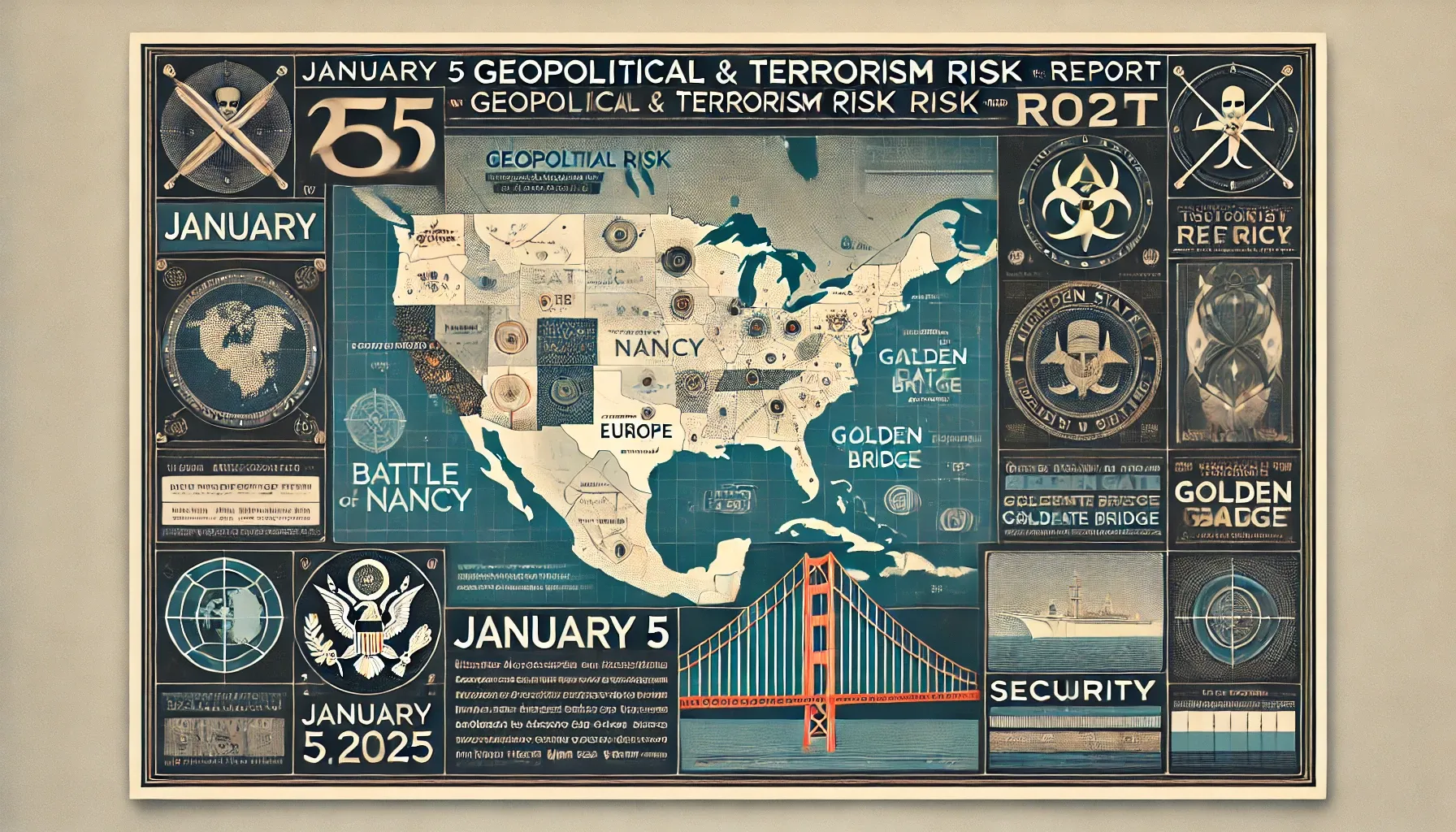Prime Rogue Daily Risk Report: January 5, 2025
Executive Summary
January 5, 2025, combines historical anniversaries and ongoing geopolitical tensions to create a complex security environment. Events like the Battle of Nancy and the Golden Gate Bridge’s construction anniversary resonate symbolically, while recent attacks in New Orleans and Las Vegas emphasize the persistence of domestic terrorism and lone-actor threats. This report identifies specific risks to regions, industries, and public spaces, providing actionable insights for stakeholders.
1. Historical Significance and Symbolism
- Battle of Nancy (1477):
- The decisive defeat of Burgundy’s Charles the Bold continues to hold symbolic weight in European political and cultural memory. Extremist or nationalist groups may leverage this anniversary for demonstrations or violent acts, particularly in Central Europe.
- Construction of the Golden Gate Bridge (1933):
- A symbol of American resilience, this anniversary could attract both celebratory and oppositional narratives. Cyberattacks or physical threats targeting critical infrastructure in the U.S. could be timed to coincide with this day.
2. Recent Events Shaping Risks
Recent Attacks
- New Orleans Terror Attack (January 1, 2025):
- A clear reminder of the threats posed by radicalized individuals, with an emphasis on IEDs in urban settings. This method is likely to inspire copycats in major U.S. cities.
- Las Vegas Vehicle Ramming Attack (January 2, 2025):
- The tactical use of vehicles against pedestrian-heavy zones highlights vulnerabilities in public spaces, suggesting the need for immediate protective measures.
Ongoing Geopolitical Trends
- U.S.-China Cyber Tensions:
- Cyberattacks against critical infrastructure or financial institutions are likely as diplomatic relations remain strained.
- Middle Eastern Proxy Conflicts:
- Increased militia activity in Israel and neighboring states, with a heightened risk of spillover attacks into Western-aligned nations.
3. Predictive Analysis
Potential Targets
- Urban Public Gatherings:
- Locations: Tourist hubs like San Francisco (Golden Gate Bridge area), New York (Times Square), and Washington, D.C.
- Rationale: High visibility combined with historical significance makes these attractive to extremists.
- Transportation Infrastructure:
- Locations: Major airports (e.g., JFK, LAX), train stations (e.g., Grand Central, Union Station).
- Rationale: High foot traffic and symbolic importance, especially amid holiday travel.
- Financial Systems:
- Locations: U.S. and EU stock exchanges, major banks.
- Rationale: Significant anniversaries tied to Wall Street and ongoing trade disputes increase risks of cyber or coordinated physical attacks.
Likely Attack Vectors
- Improvised Explosive Devices (IEDs):
- Targets: Crowded urban centers, government buildings, or symbolic locations (e.g., the Golden Gate Bridge).
- Details: IEDs disguised as common objects (backpacks, trash bins) in public areas.
- Vehicle Ramming Attacks:
- Targets: Open-air markets, pedestrian promenades.
- Details: Use of large vehicles in areas with limited barricades or security measures.
- Cyberattacks:
- Targets: Financial institutions, energy grids, and government websites.
- Details: Ransomware aimed at destabilizing operations and sowing fear.
High-Risk Regions
- United States:
- Key Cities: San Francisco, New York, Washington, D.C., and Las Vegas.
- Risks: Domestic extremism leveraging high-profile locations for symbolic attacks.
- Europe:
- Key Cities: Paris, Brussels, and Berlin.
- Risks: Increased nationalist protests or lone-actor attacks tied to political anniversaries.
- Middle East:
- Key Areas: Israel, Gaza, and neighboring states.
- Risks: Cross-border militia attacks or proxy strikes on allied infrastructure.
4. Implications for Stakeholders
Businesses
- Cybersecurity:
- Conduct immediate reviews of cyber defenses, particularly for financial institutions and energy operators.
- Event Security:
- Deploy enhanced security at high-traffic locations, particularly those tied to commemorative events.
Government Agencies
- Intelligence Monitoring:
- Increase surveillance of domestic extremist chatter, particularly around high-visibility urban sites.
- Infrastructure Protection:
- Conduct drills to test responses to potential vehicle attacks or cyber disruptions.
General Public
- Situational Awareness:
- Avoid large gatherings at iconic landmarks unless security measures are visibly heightened.
- Reporting:
- Actively report suspicious activity or unattended items in crowded areas.
Conclusion
January 5, 2025, is emblematic of the interplay between historical symbolism and modern security challenges. The anniversaries tied to this date, combined with recent terrorist incidents and geopolitical pressures, demand heightened vigilance. Stakeholders are urged to take proactive measures to mitigate risks and safeguard against evolving threats.
